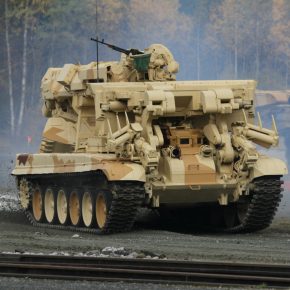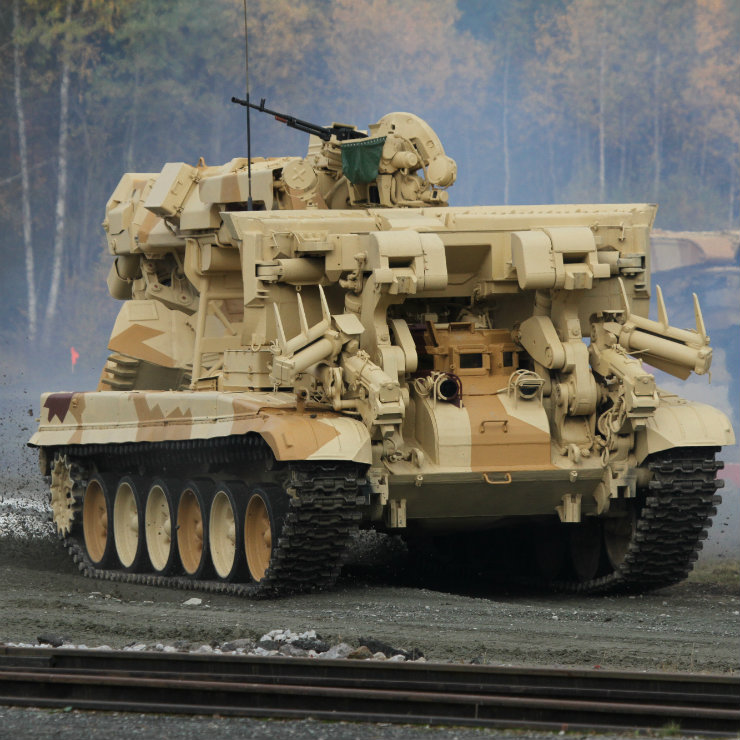Russia is too small to win the war in Ukraine
Category: Macroeconomics

(Vitaly V. Kuzmin, CC BY-SA)
In SIPRI’s latest report titled “Trends in International Arms Transfers, 2018” Russia is still the world’s second largest arms exporter, but the gap between Russia and the United States has been widening in recent years. While the US arms exports grew by 29 per cent between the two periods, increasing share of total global arms exports from 30 per cent to 36 per cent, Russian share of the global arms exports market decreased from 27 per cent to 21 per cent, according to the report. The fall in Russia’s global arms export share is, in part, the result of general reductions in arms imports by Russia’s long term major arms import partners — India and Venezuela.
“Although India remained the chief recipient of Russian arms in 2014-18, Russian arms exports to India fell by 42 per cent between 2014-18 and 2009-13. Arms exports to Venezuela, which was the fifth largest recipient of Russian arms in 2009-13, decreased by 96 per cent between the two periods,” the report says. The decreasing demand for arms by India has hit Russia particularly hard. According to the report, India’s import of arms decreased by 23 per cent between 2009-13 and 2014-18.
“The decline in India’s import is also partly due to delays in deliveries of arms produced under license from foreign suppliers, such as combat aircraft ordered from Russian in 2001 and submarines ordered from France in 2008,” according to the India’s daily Business Today. In the period between 2009-13, Russia accounted for 76 per cent of total Indian arms imports, compared with 58 per cent in 2014-18.
Besides India and Venezuela, between 2014-18, Russia delivered major arms to 46 countries. More than half of Russia’s overall arms exports went to only three countries: China, India and Algeria. “At the regional level, Asia and Oceania accounted for 60 per cent of Russian arms exports in 2014–18, Africa for 17 per cent, the Middle East for 16 per cent, Europe for 5.8 per cent and the Americas for 1.4 per cent,” the report says.
One of Russia’s largest state corporations Rostec, a conglomerate comprised of about 700 enterprises, many of which in the defense-industry, was quick to dispute the numbers published by the prestigious Swedish institute.
“SIPRI’s data regarding the decrease in volume of Russia’s arms exports do not correspond with reality. The methodology used for the calculations raises many questions. Over the past 10 years, we have recorded growth in sales volumes,” Rostec’s press spokesperson told Ria Novosti adding that “Rosoboronexport’s supply plan for 2018 was fully implemented, reaching a record-breaking sales volume of USD13.7bn.”
Rostec also reported that during the latest period analyzed by the SIPRI team (2014-18) Rosoboronexport increased its export deliveries of military products and entered into new business partnership in Asia, Africa, Latin America, and the Middle East. “Among the largest deals are contracts for the supply of S-400 complexes to China and India. At the end of 2018, Rosoboronexport’s order book exceeded the value of USD51bn, that is the highest number in 10 years,” Rostec’s press release reads.
Russian arms industry in second place
According to a different SIPRI’s dataset featuring the world’s 100 largest arms-producing and military services companies, published in December 2018, in 2017, Russia became the second largest arms producer, surpassing the United Kingdom, which had occupied the second place since 2002. “The combined arms sales of Russian companies accounted for 9.5 per cent of the Top 100. Taken together, the arms sales of the 10 Russian companies listed in the Top 100 increased by 8.5 per cent in 2017, to USD37.7bn,” the report says.
“Russian companies have experienced significant growth in their arms sales since 2011,’ writes Siemon Wezeman, Senior Researcher with SIPRI’s Arms and Military Expenditure Program. “This is in line with Russia’s increased spending on arms procurement to modernize its armed forces.”
In 2017, a Russian company has appeared in the top 10 for the very first time since SIPRI started compiling its annual Top 100 list. “Almaz-Antey, which was already Russia’s largest arms-producing company, increased its arms sales by 17 per cent in 2017, to USD8.6bn,” reports Alexandra Kuimova, Research Assistant with SIPRI’s Arms and Military Expenditure Program.
However, despite the apparent successes of Russian defense companies, Russia’s overall military expenditure has been on the decline. Last year, the Washington Post informed that Russia’s military spending fell from USD69.2bn in 2016 to USD66.3bn in 2017. It was the first time Russian military spending fell since 1998, according to the WP.
Filip Brokeš is an analyst and a journalist specializing in international relations.


